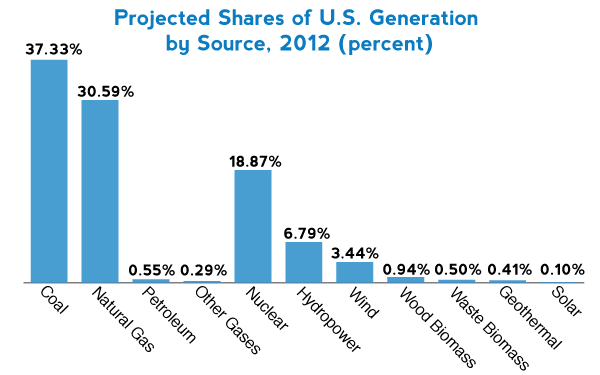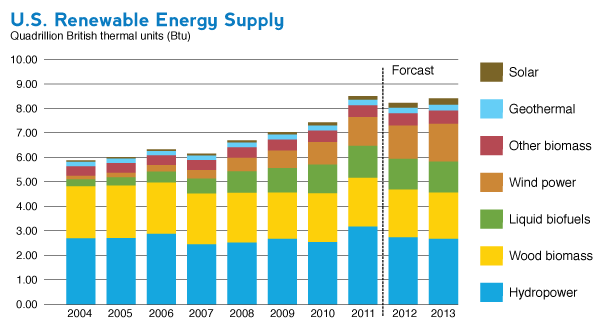Renewable generation reached large gains in 2011, but that increase was due to a very good hydroelectric year. Hydroelectricity in 2012 is on the decline, producing 14 percent less electricity through the first 7 months of this year compared to last year. Through the first 7 months of 2012 hydroelectricity produced 30 billion kilowatt hours less electricity than through the first 7 months of 2011. The forecasters at the Energy Information Administration (EIA) expect that trend to continue and that the increases in other renewable energy (wind, solar, and geothermal) will not make up the difference in hydroelectricity’s decline this year. In fact, EIA expects total renewable energy consumption to decline by 2.6 percent in 2012 due to hydroelectric power generation returning to its long-term average level.
EIA’s Forecast for Renewable Energy
EIA, in its Short-Term Energy Outlook[i], is forecasting that hydroelectric generation will decline by 13.6 percent this year, and while other renewable energy will make gains, they will not be sufficient to compensate for the losses in hydroelectric generation. EIA predicts wind power increases by 16 percent, solar power by over 100 percent, geothermal by 9.5 percent, and wood/waste by 2.6 percent—a total increase for non-hydroelectric renewable generation of 12.6 percent.
Source: Energy Information Administration, Short-Term Energy Outlook, http://www.eia.gov/forecasts/steo/pdf/steo_full.pdf
While solar power has a huge percentage increase, its base is so small that its increased generation is smaller than that of wind power and in concert with the other non-hydroelectric renewable energy sources of generation. For comparison purposes, solar power’s projected generation in 2012 would supply about one-third of Maine’s 2011 electric power needs.
In 2011 and 2012, hydroelectric power still makes up over 55 percent of renewable generation, with all the other sources combined making up the rest. And nuclear generation that makes up about 19 percent of our total generation supplies over 50 percent more electricity than all of our renewable generation sources combined.
Also expected to decrease is the production of ethanol due to the severe drought in the Midwest this summer, but the decrease is small measured on an annual basis—less than 1 percent between 2011 and 2012. But just looking at the summer period, the drought conditions that depressed corn harvests caused ethanol production to fall from 890 thousand barrels per day during the second quarter of 2012 to 806 thousand barrels per day in October 2012—a drop of over 9 percent.
Source: Energy Information Administration, Short-Term Energy Outlook, http://www.eia.gov/forecasts/steo/pdf/steo_full.pdf
EIA expects renewable energy consumption to increase in 2013 as nonhydropower energy increases by 5 percent while hydroelectric energy declines by another 2.5 percent. This 5 percent increase results even without a production tax credit (PTC) extension because EIA forecasts assume current laws and regulations and thus counts the PTC for wind power as expiring at the end of this calendar year. Wind generation increases by almost 14 percent in 2013 due to renewable electricity standards of 30 states and the District of Columbia requiring increased generation from qualifying renewable sources in the future. Wind power increases the most in absolute terms and solar power increases the most in percentage terms—68 percent in 2013.
In EIA’s short-term forecasts, ethanol production remains about flat in the first half of 2013 and then recovers in the second half of 2013, averaging over 850 thousand barrels per day or 13 billion gallons for the year. Lower domestic ethanol production results in more imports and higher domestic production results in greater exports.
Conclusion
With or without a production tax credit, EIA expects wind generation to increase in 2013. As the least expensive nonhydroelectric renewable technology, onshore wind energy is being built to satisfy state laws that mandate future generation from renewable technologies that qualify.
Hydroelectric generation hit its highest level since 1997 in 2011, and EIA expects its generation to continue on a downward trend through 2013, returning to its long-term average level.
While solar generation has seen large percentage increases recently and EIA expects them to continue, the amount of solar generation and its contribution to the nation’s electricity supply remains small.
[i] Energy Information Administration, Short-Term Energy Outlook, November 6, 2012, http://www.eia.gov/forecasts/steo/pdf/steo_text.pdf

